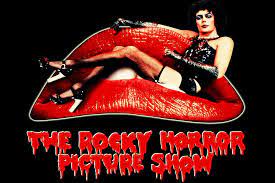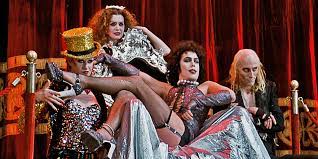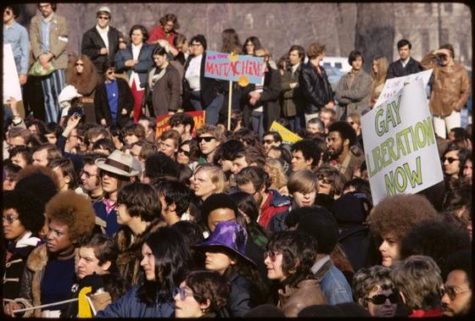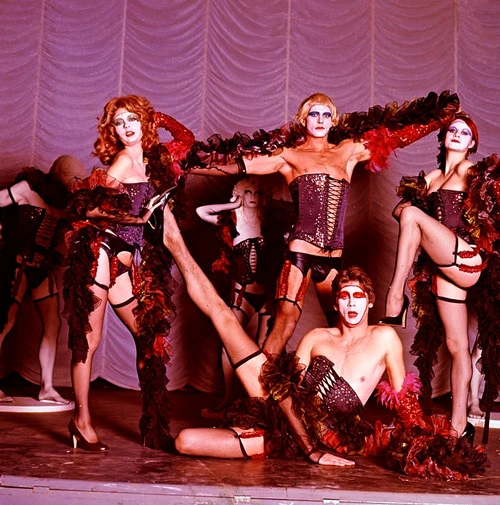LGBTQ Representation in The Rocky Horror Picture Show

November 29, 2022
The eccentric film The Rocky Horror Picture Show has been a staple in the LGBTQ community since its initial release in the 1970s. The film introduced Dr. Frankenfurter, a transsexual scientist who dresses in high heels, fishnets, a corset, pearls, and booty shorts– all very taboo during that decade. The film also depicts gay, lesbian, and poly-amorous relationships– again, very taboo topics. These plot points served as representation for LGBTQ viewers who did not see themselves represented in the media, since the topic was very “don’t ask, don’t tell”. This film opened the door for more LGBTQ representation in the media and continues to do so in the 21st century.

Around the time of the film’s release, there were many monumental events occurring for the LGBTQ community that made the representation in the film all the more salient. Three years prior to its release, the Baker v. Nelson case that faced the Minnesota Supreme Court had ruled that state law prohibits same-sex marriage, and is limited only to opposite-sex marriage. When it was elevated to the US Supreme Court, they dismissed the appeal. Years later, in 1973, American Psychiatric homosexuality is no longer a psychiatric disorder.
Later, the year of the film’s release had many major events that impacted the community. Firstly, the US Civil Service Commission declared that it will no longer exclude homosexuals from government employment. Then Elaine Noble became the first ever openly lesbian legislator, as she takes her seat in the Massachusetts House of Representatives. Finally, Minneapolis became the first US city to protect transgender individuals by amending its local non-discrimination law. May marches for gay rights accrued during this year, including one of the most well-known ones in Boston in 1975.

When the film was released, it was very unpopular and frowned upon. It was both a critical and financial failure, and made conservative viewers astonished that such a thing was ever allowed to be shown in theaters. This is because of the large fear of homosexuality, and the “influence” conservatives thought it would have on younger generations. The thought of being inclusive and accepting everyone despite their differences was not one conservative older generations were fond of.
However, the film quickly gained a die-hard cult following. On April Fools Day in 1976, almost a year after the film’s release, the staff at Waverly Theater decided to replace its midnight showing with a showing of The Rocky Horror Picture Show. The manager of the Waverly Theater, Denise Borden, was fascinated with the film and put up advertisements for the showing, saying “This is a film not to be missed”.
Denise played the recording studio album of The Rocky Horror Picture Show soundtrack before the film to “warm up” the audience. As a result, the audience began to respond to the lines by booing the villains and cheering on the heroes. After the showing, there would be a group of regulars who would come to every midnight showing of the film after that. They reserved the same seats in the front row of the balcony. A few months later, at the Memorial Day Weekend showing, one person in the audience yelled out to the screen “Buy an umbrella, you cheap b—-!” This was what sparked more callbacks to almost every line in the film. Other examples include the audience saying “And laugh at funerals” when the wedding guest in the film cries “I always cry at weddings” and the audience yelling “Where is his neck, he has no neck!” every time the Scientologist in the film appears on the screen.

A few showings later, some of the audience members began to lip sync to the film, mouthing the words and doing the dances with each other. Some even dressed up as the characters, especially Dr. Frank-n-Furter, Riff-Raff, Magenta, Rocky, and Columbia. With this, the cult following was born, as every weekend people would dress up as the characters and perform the show as it was playing behind them (this was called a shadow performance). They would bring props, such as toast and rice to throw at the screen, and they would say their own callbacks to the lines. These shows still occur frequently today, especially in Washington DC, Chicago, Los Angeles, and New York City.
These live shows became such a safe place for individuals in the LGBTQ community because it was a place in which they could be themselves without judgment. YouTuber Matt Baume explains his experience, looking back on when the movie was released; “A lot of doctors still considered homosexuality a mental illness. Being gay was illegal in large parts of the country,” he said. “The social pressure to be straight, to disguise yourself, to never give yourself over to what felt right was overwhelming.” Baume continued.

The film’s main characters– as we discover at the end of the film– are aliens, which to many viewers seemed far-fetched and ridiculous. But some viewers understood the analogy of aliens to be about the LGBTQ community. Baume explains this analogy in the same video saying “Rocky Horror is a movie by, for, and about people who feel like aliens and outsiders.” The film was an opportunity for people who felt like aliens to be seen and represented. In making this film, Richard O’Brien, the creator of The Rocky Horror Picture Show, allowed people who felt like they were not seen, people who felt like outsiders, to be recognized on screen, and the cult following allowed a place where they could be themselves without judgment.
The film is, without a doubt, ridiculous and, to be frank, all over the place. From weddings, to wild dances, to crazy experiments, to a frozen motorcycle riding saxophone player, to two cheating fiances, to cannibalism, to turning people into statues and making them perform ridiculous costumes, to aliens being killed with lasers. But more important than all those things, the opportunity it gave the LGBTQ community to finally feel seen after years of discrimination and feeling like “aliens”. “The movie says to [the community], ‘Don’t worry, you’re not alone ― people like us can find each other at parties in the movie, and parties in real life.’”